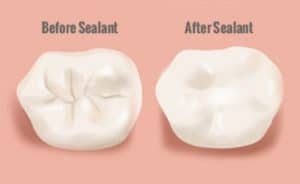Have you noticed that most dentists no longer use metal when filling a cavity? Today, the majority of dentists have switched to composite fillings, and for good reason.
“Composite is superior to metal for multiple reasons,” says Dr. David Brusky. “In fact, I haven’t used metal in more than 22 years. One reason why patients like composite fillings is because the material matches the natural color of the tooth, making it much harder to spot in the mouth. But the reasons I use composite go far beyond just mere aesthetics.”
A metal, or silver amalgam, filling only works to fill a gap but doesn’t actually work to hold the tooth together. In fact, the metal will actually expand and contract due to changes in temperature in the mouth. And that can lead to cracks in the teeth that require additional attention.
“Quite often, I have patients coming to my office who require work on a previous filling site,” says Dr. Brusky. “They may have excellent oral care, but they cannot control what happens to the metal in their mouth. And over time, the metal that was supposed to repair your tooth might actually cause even more damage to it.”
Composite bonds to the existing tooth structure, which prevents future breakage and can actually insulate the tooth from temperature changes in the mouth.
Composite can also be found in liquid form, which allows for a dentist to repair a cavity much smaller that he would otherwise be able to with another filling material. And this thereby increases the strength of the tooth. To fill a small cavity with a silver amalgam filling, the dentist would need to remove enough healthy tooth structure to create an area big enough to be filled properly with the silver. That can harm the strength of the tooth, leading to breakage and the need for additional work in the future.
“Composite fillings are slightly more expensive than silver amalgam fillings,” says Dr. Brusky. “But the investment you make in your teeth today can very well save you additional time and money in the future.”
Additionally, should a problem arise in a tooth that already has a composite filling, it is much easier to repair than one with an amalgam filling because you can add new composite to the old one. To repair a tooth with an amalgam filling, the entire amalgam must be removed and replaced.
Many people are also focusing on ways to be healthier, and turning to organic foods and products for themselves, and looking for ways to lessen their impact on the environment. For this reason, composite fillings are a great alternative to silver amalgam ones.
Amalgam fillings contain mercury, and in the U.S., dentist offices are actually the second largest users of mercury. While the amount of mercury used in fillings has been deemed safe by the FDA, many would prefer not to have it in their system, or on the environment.
“Many other countries have concerns about the use of amalgam and its impact on the environment and our bodies,” says Dr. Brusky. “Denmark, Sweden, and Norway have banned the use of amalgam and countries like Canada, Italy and Australia have all implemented steps to greatly reduce the use of amalgam. Forty-seven other countries have signed an initiative calling for the restriction and eventual prohibition of dental amalgam fillings.”
To preserve the strength of your tooth and to preserve the beauty of your smile, composite fillings provide the most ideal solution when faced with a cavity. But they are also healthier for you and the environment.
If you have questions about amalgam fillings you may currently have, or have experienced a problem in a tooth with an amalgam filling, schedule a consultation with Dr. Brusky today by calling (920) 662-1440.






